One of the key requirements of maintaining the quality of a reef tank is keeping its salinity level strong. But the challenging part is to keep the salinity rate stable. Although it is a little challenging to keep the salinity rate stable, it is a vital part of maintaining a reef tank.
There is an ideal level of sanity that you should aim for a reef tank. The recommended level is 1.024 – 1.025, which means 32 parts per thousand (ppt) to 33 parts per thousand (ppt). But if the level is slightly below/above the level like somewhere between 1.022 and 1.027, it is also fine.
You are not thinking this is all, are you? Because it really is not! There are some other things about salinity, especially about its measurement. To get a solid idea about salinity, you are invited to read the full article.
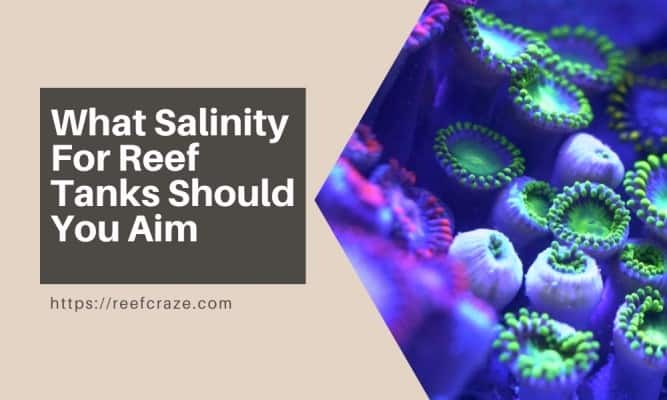
Why Is Salinity Even Important For Reef Tanks?
Good question. Before entering the main discussion, if you are wondering why salinity is an important issue for reef tanks, I’ll tell you why.
Although a great number of tank inhabitants are bred as well as raised in farms, many of them that are sold to hobbyists are caught from the natural reservoirs. So, when the wild animals are caught and held captive in a reef tank, it is really important that the environment inside the rank is exactly the same as the natural environment from every aspect.
By every aspect, it means the space limitation of the reef tank, the levels of dissolved oxygen in the water, conflicts caused by the animals’ cohabitation, the salinity of the water, etc. Among these, the salinity of the saltwater tank alone is enough to cause the newly caught animals to become stressed.
Even if you are a mere hobbyist, I am sure you know that stress is one of the most important factors that have the biggest impact on the health of your tank inhabitants. So, if your reef tank does not have enough or constant salinity in its water, it is a matter of time when it causes the inhabitants to become stressed, and then sick, followed by death eventually.
Additional Read: Best Reef Salts You Can Buy
In simplest terms, salinity represents the salt concentration in your reef tank. If you dive a little deeper (pun intended), you will find that it plays a significant role in the overall health of your tank’s inhabitants. A balanced salinity level, usually between 1.023 and 1.025 Specific Gravity (SG) in reef tanks, keeps the fish and corals comfortable and thriving. However, any abrupt changes might turn this vibrant sanctuary into a stressful environment for its inhabitants.
The careful management of salinity begins with understanding how to measure it accurately.
How Do You Measure The Salinity of Your Reef Tank?
Now that you understand the importance, we can move on to the main part – measuring the salinity. There are 3 ways of measuring salinity. You can use a hydrometer, an electronic salinity meter, or a refractometer to do this.
I am going to discuss each of them so you can make an informed decision about which device to use according to your convenience.
1. Using A Hydrometer:
A hydrometer measures the liquid’s density which is made of a combination of three things – the levels of dissolved salt, pressure, and temperature.
The density of the liquid is referred to as specific gravity that, in this context, is the ratio between the density of water and the density of pure water. The specific gravity of pure water is 1 whereas natural sea water’s specific gravity is 1.027. So, its density is 1.027 times more than that of pure water.
While many people do not care much about temperature, it is necessary to take it into consideration. Hydrometers are designed to work at a specific level of temperature (20°C/68°F).
This means that when you prepare everything to read the salinity level of your reef tank, make sure the temperature level is right. Otherwise, the hydrometer may not work properly.
In case you are using a float hydrometer, it is suggested that you make a table to correct the measurements taken at different levels of temperatures. There are other hydrometers as well. Some of them (like swing-needle hydrometers) are considered to be self-correcting for temperatures.
However, using a hydrometer is a good and inexpensive way of measuring salinity. But it often provides less accurate results. To solve this problem, you may try using other devices.
2. Using An Electronic Salinity Meter:
This device is used for measuring the conductivity of the salt water, working on the matter that the more concentrated solutions are, the easier it is to conduct electricity. The meter then translates the reading into the equivalent amount of salinity.
This meter requires regular calibration and proper cleaning after it is used. It provides enough accuracy in measuring the salinity of tank water. But it is expensive when compared with the other two devices.
3. Using A Refractometer:
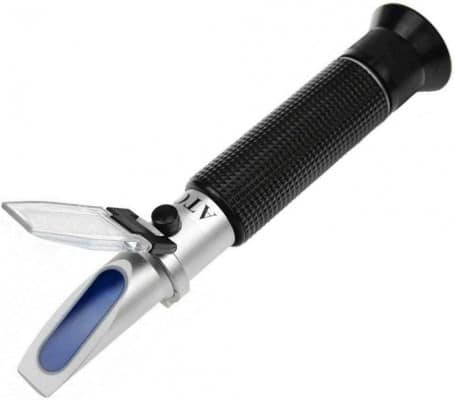
A refractometer usually measures the liquid’s refractive index that differs with the concentration level of the dissolved salt in the water. It is often self-correcting depending on temperature.
It provides more accuracy than a hydrometer. It is also a little expensive. It requires to be calibrated occasionally with fresh and pure water that sets its zero point. And it has to be cleaned carefully after each time it is used.
My Favorite Refractometers: Editors Choice
Best Handheld Refractometer
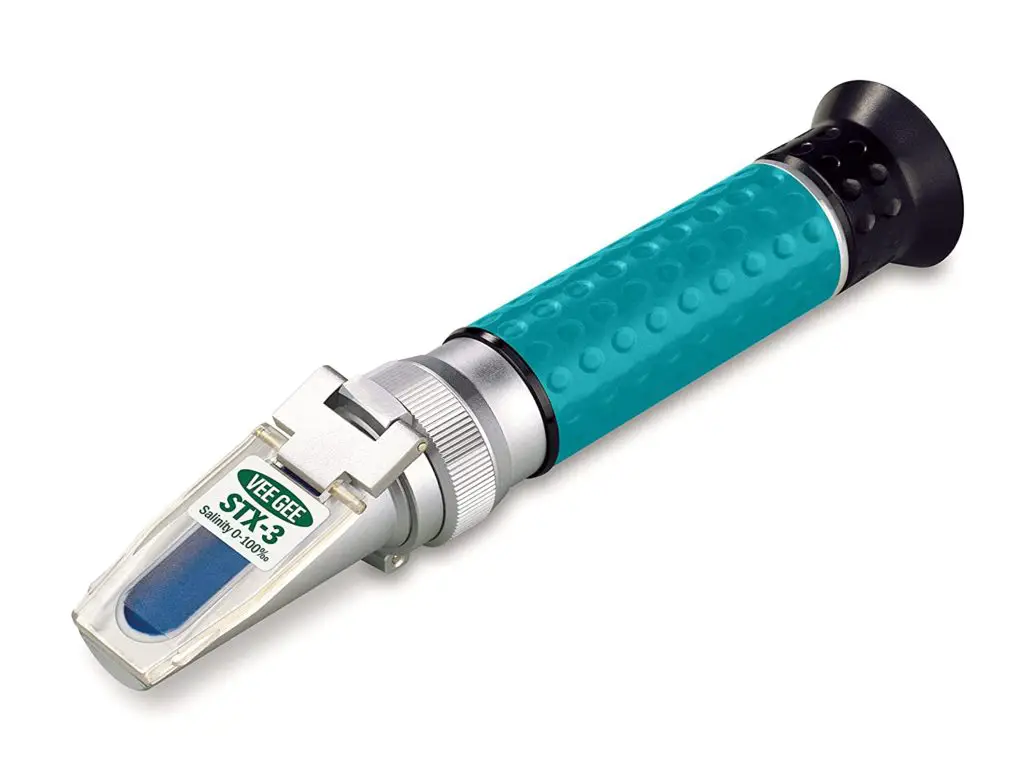
Best Digital Refractometer
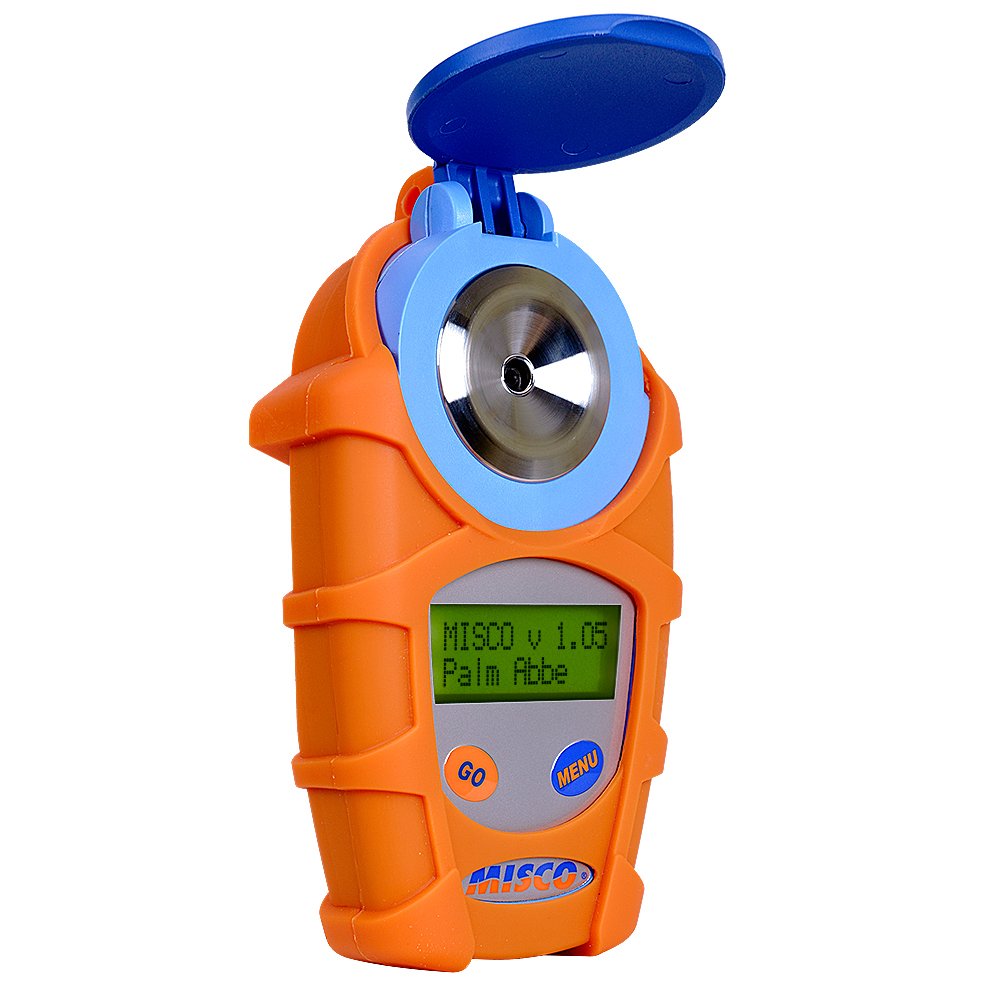
Which Device Should You Use to measure the reef tank Salinity?
Which device you should use to measure your tank water’s salinity largely depends on your own choice. Nevertheless, you might want to consider the following facts before jumping on a decision.
Electronic meters and refractometers both are more accurate than hydrometers. But they are pricier than hydrometers. They are kind of high maintenance requiring regular calibration and careful cleaning.
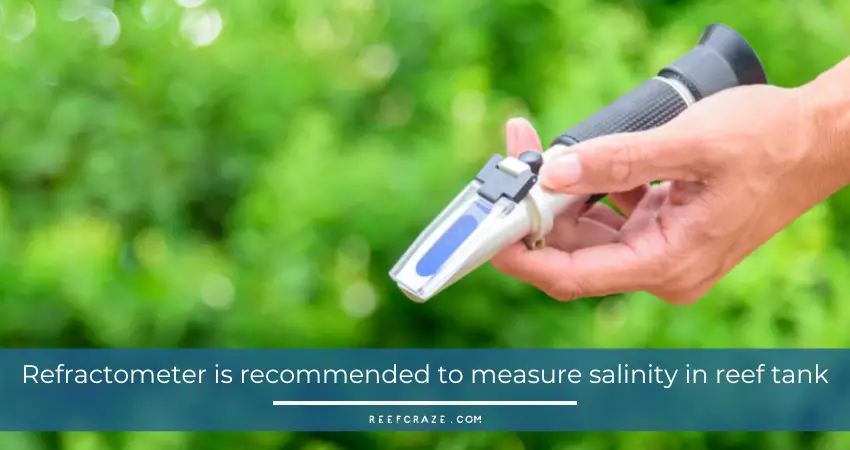
Besides, that your tank water is supposed to have a consistent rate of salinity should be given more importance than getting the exact measurement of PPT. So it will not be a bad choice if you decide to use a hydrometer.
But as you will have to adjust salinity very carefully, particularly when you use water with reduced salinity for treating the ill inhabitants in your reef tank, it is recommended that you use either an electric meter or a refractometer.
Hydrometers vs Refractometers
While both devices serve the same purpose, refractometers are generally considered more accurate and reliable than hydrometers. The table below provides a comparison of these two devices.
| Hydrometer | Refractometer | |
|---|---|---|
| Accuracy | Lower | Higher |
| Reliability | May be affected by air bubbles or debris | Unlikely to be influenced by external factors |
| Cost | Less expensive | More expensive |
| Ease of use | Easy to use | Slightly complex for beginners |
Despite their differences, understanding how to use each tool properly is key to getting accurate readings.
What Causes Changes In The Level Of Reef Tank Salinity?
You have to regularly check the salinity level because it changes over time. If not properly monitored and taken care of in time, salinity will make your tank inhabitants stressed and sick. Now, have a glance at the reasons that cause changes in the level of salinity.
1. Evaporation:
The tank water slowly evaporates over time, leaving the salt in the remainder of the water. Then there will be less water with the unchanged amount of salt, meaning that there is more salt than there should be. This changes and increases the salinity level.
If you are not monitoring very carefully, you may not even notice the water evaporating and leaving the salt in the water. It may even happen that when you notice it at last, it is too late.
To prevent it from happening, you can mark the level of the tank water. It will be really helpful for you.
2. Salt Creep:
If you see a crusty salt buildup around the edge of the reef tank, it means the salt is not dissolved in the tank water any longer. This reduction in salt can also cause changes by decreasing the salinity level.
3. User Error And Water Changes:
User error is one of the common causes that fluctuate the salinity levels. If you top off the reef tank with a lot of fresh water or fail to test the added amount of water, each water change will seriously cause changes in the salinity levels.
4. Others Reasons That Effect Salinity
Protein skimmers, removal of plants and other decorations, and new specimens will remove a little amount of salt from the tank water.
It is not much, but it can amount to a good quantity over time. So, you should be careful about this stuff too.
What Can You Do To Keep The Level Of Salinity Stable?
To learn what you can do to maintain the stability of the salinity level, follow the following instructions in accordance with your situation.
If The Salinity Level Is Low:
In this case, it is recommended that you make several water changes using higher salinity water and increase the salinity to its recommended level.
For instance, if your tank water’s salinity is 1.022, you should make 5% water changes on a weekly basis with water having a salinity level of 1.030. Every time you change the water, test the tank water’s salinity, and observe the changes in its level.
If The Salinity Level Is High:
When the salinity is more than it should be, change the tank water with new water having a lower salinity level. You can also replace a few volumes of tank’s water with Reverse Osmosis Deionized water. It will change the salinity to its recommended level.
Pieces Of Advice:
It will be easier for you if you always keep a certain amount of premixed saltwater at your home so you can instantly fix the salinity level whenever necessary.
You can also try using a sump system for your reef tank. It increases the volume of tank water and thus can be a great solution for the evaporation problem.
Regularly Monitor and Maintain Salinity Levels
There’s no one-size-fits-all approach when it comes to maintaining salinity, but some proven tactics can help.
Frequent Measurement: A Proactive Approach
It’s vital to check the salinity at least once a week. Regular monitoring can help detect any shifts in salinity early, allowing for prompt corrective measures.
Adjustment: Adding Fresh Water vs Adding Saltwater
If salinity is too high due to water evaporation, top up with fresh water. Conversely, if salinity is too low, perhaps because of the introduction of new tank inhabitants, it can be increased by adding saltwater.
Use of Auto Top-Off (ATO) Systems
An Auto Top-Off (ATO) system automatically adds freshwater to the tank when it detects a drop in the water level due to evaporation. This helps maintain a constant water level and thus a stable salinity.
With these strategies in hand, you are well on your way to mastering salinity adjustments in your reef tank.
Final Words
To sum it up, it is mandatory that you keep the level of salinity in your tank water as stable as you can. A little change from the recommended level will pose a threat to your tank inhabitants’ lives.
It might take some of your efforts to keep repeating the task every once in a while. But if you have the proper equipment and can test the water regularly, it will soon become easy for you to keep the level of salinity constant.
By taking proper precautions, you can ensure that the tank environment is almost the same as the natural environment. In return, it will reward you with some happy and healthy saltwater inhabitants!

